It was a very early morning start for the 7 hour flight to Singapore's wonderful Changi Airport (a holiday destination on its own) where we transferred for another 2 hours to Phuket. There we were picked up in our mini bus and taken to the Cape Panwa Hotel.
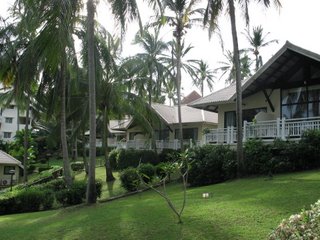
I first came across this hotel as a setting for a TV cooking show. I was so impressed I went to my travel guru, tripadvisor.com, read the reviews and made a booking to celebrate my 60th birthday.
We were not disappointed and spent eight great days with almost perfect weather despite being the monsoon season. We were accommodated in rooms overlooking the harbour. These were large and well appointed with aircon that worked well and beds that were comfortable. Staff at all levels were friendly, helpful and went out of their way to make our holiday enjoyable.
Sure the hotel is a bit out of the way. But this is a blessing in disguise. It makes for a peaceful holiday especially for families, romantics and old farts like us (some company excluded).
We ate in all the restaurants. Breakfast was little bit of a hit and miss affair as is the case with any buffet. Thai dinners or lunches at the Cafe Andaman was always good. A special Thai dinner at Panwa House was also excellent.

We celebrated the birthday at the Top of the Reef after drinks in Otto's Bar and the staff went out of their way to make the party a success, even providing a surprise bithday cake with candles and hearty staff rendition of the song! The food here is expensive by Thai standards but 50% of what you would pay in Australia at a similar venue. Wine is very expensive in Thailand so we stuck to Singha beer at most venues but as this was a special occasion we enjoyed a good Italian red and French white selected from a broad wine list.
The beach was a focal point for us. Tide charts in the rooms provide the best time for swimming and for us this always appeared to be between 8am. and 2pm. Water was not all that clear (by Pacific Island standards) but warm and clean. Sitting on our lounge chairs under the palms and strategically placed umbrellas with beer in hand (thank you, Manop), was a perfect way to spend most of the day. The tide goes out in the afternoon to reveal a coral reef that is good to explore via a concrete pathway although it's not by any means the Great Barrier Reef.

Both swimming pools were kept immaculately clean and with virtually undetectable chlorine levels. Our favourite was the one at the beach, deserted on most occassions.
You have to be a little bit fit to stay at the Panwa. Lots of steps no matter where you go. But it helps work off the food.
We ate a few times at the Sawasdee, a small family restaurant in Panwa Village, just over the hill and reached by hotel shuttle bus. Here was very cheap food of good quality served by a lovely staff. As a person who could eat Thai food every meal I was in foodie heaven! There are prawn cakes, fish cakes and spring rolls among other things as starters, spicy soups and salads, stir fries of chicken, seafood and meat flavored with different herbs and spices, fried rices, noodles, red, green and yellow curries and woked fried seafood just to mention a few dishes. Some come with quite a chilli kick so you have to be a little bit careful. The usual bowl of steamed rice can save your head from being blown off.

Although it was tempting to just chill out at the hotel we did a little bit of touring. Our initial trip was a "orientation tour" of the south part of the island. I have been visiting Thailand since the late 1960's initially on business and for the last 15 years as a tourist. I have grown to respect the Thai people, their culture, gentle humour and way of life. So it was with a little trepidation that I returned to Phuket after a 20 year absence. I have to say that the tourist boom may have done wonders for the island economically but nothing much for the image of Thailand. Off the beaten track, you can still find the essence of the country but on the well trodden tourist routes there is little to attract. Patong the main tourist centre is an ugly town where the beach is a dirty strip of sand covered in thousands of beach chairs where people lie cheek by jowl and listen to jet skis whine their way around the bay. Why anyone would want to spend any time here is beyond me.
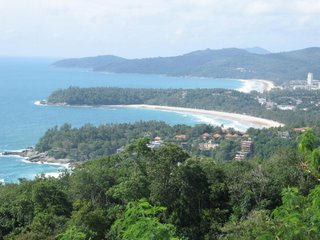
The surrounding coastal area from Kata, Karon and north has been developed to an inch of its life. There was no evidence of tsumani damage and it was here that the worst destruction occurred. It just seemed a pity to me that they hadn't taken advantage of the situation and rebuilt the area in a more environmentally friendly way.
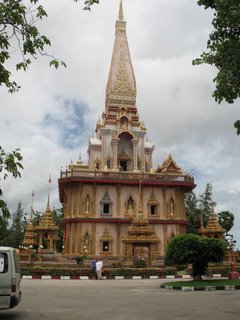
Thailand is predominantly a Buddhist country and a visit to a temple or wat is mandatory. They are always colorfully and extravagantly decorated and accessible by all faiths as long as you are suitably dressed. Wat Chalong was no exception.
This is Phuket’s most important Buddhist temple and is the biggest and most ornate of Phuket’s 29 Buddhist monasteries. The architecture is typical of wats found throughout Thailand.
Wat Chalong is associated with the revered monks, Luang Pho Chaem and Luang Pho Chuang, both of whom were famous for their work in herbal medicine and tending to the injured. During the tin miners’ rebellion of 1876 they mobilized aid for the injured on both sides. They also mediated in the rebellion, bringing the warring parties together to resolve their dispute. Statues honoring them stand in the sermon hall.
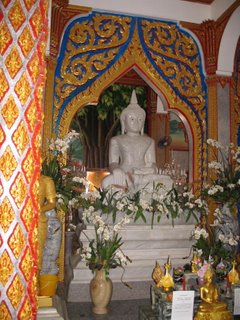
Many Thais come here to be blessed by the monks and receive a good luck charm in the form of a string tied around the wrist, which they believe protects them from injury and illness.
Local Thais and Asian tourists set off fire crackers and ask for the lucky lottery numbers, and have their fortune told. The fire crackers were a little disconcerting at first. Set off in what looked like a huge brick kiln it sounded like gun fire. A sad commentary on the state of the world.
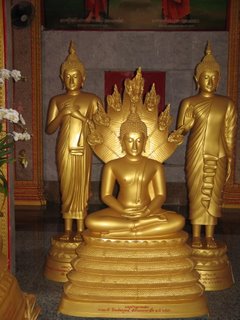
We took the June Bahtra junk day cruise to Phang Nga Bay which is wonderful.The boat was not really a junk but a converted trawler that has been rigged with junk sails and was extremely comfortable.

There were only a few of us on board so we had plenty of room to stretch out as we headed north through glassy calm waters towards the famous limestone islands of the bay. We motored for part of the way and then the sails were raised and we heeled over and the wind took us.
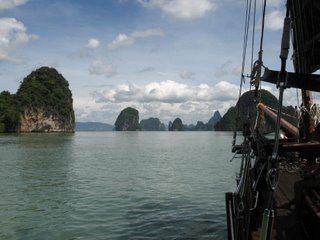
The sheer limestone cliffs jut vertically out of the emerald green water. Over millions of years, the skeletons from a constant rain of marine organisms, plus the chemical precipitation of yet more calcium carbonate build thick layers of sediment.
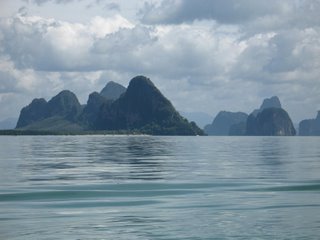
Eventually, the heat and pressure of their own weight turn these strata, hundreds of metres thick, to stone.
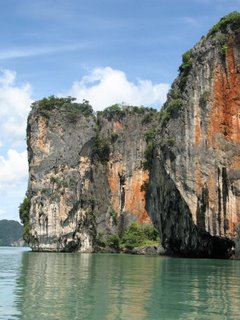
A variety of geological forces have then fractured the limestone beds and pushed up the 40 steep-sided islands that provide the exotic scenery for which this shallow bay is noted. Mineral oxides from various sources paint the vari-coloured streaks that characterise the cliffs.
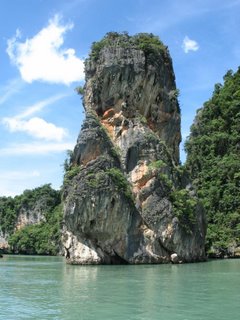
It wasn't many years ago that aerial surveys first revealed the Hong, or "rooms", that lie inside some of Phang Nga's islands. These hidden realms, rich in unspoiled flora and fauna, are collapsed cave systems open to the sky and surrounded by towering limestone walls. They can be accessed by sea-canoeing, where you paddle sturdy inflatable boats through caves (when the tide is right) into the mysterious hearts of islands such as Koh Panak and Koh Hong.
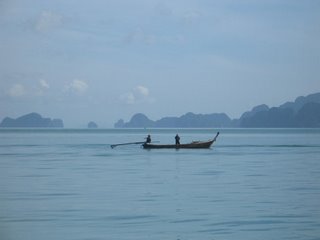
The long tail boat is a typical mode of water transport in south east Asia. It has a distinct narrow and beautifully crafted wooden hull and is powered by the famous longtail engine - basically a car or truck engine with a propeller shaft attached. The longtails can really move when the boatman opens up the throttle. Because a few places of interest were in parts of the bay too shallow for our boat we transferred (with life jackets on) to one of these and sitting on narrow wooden benches sped across the water with wind and spray in our hair. Nothing like the roar of a unmuffled 5L V8 pushing you along to stir the soul, petrolhead or not.
We made a small detour through a huge limestone grotto that is only accessible at certain times of the tide as well as to part of the mangrove forest that surrounds the northern part of the shoreline.
First stop was Koh Pannyi or Sea Gypsy Island. This is an interesting village, the whole of it, including a Mosque, built out over water on stilts and with a giant rock monolith guarding its rear. The inhabitants are of Indonesian origin but have been Thai citizens for generations and are of Muslim faith. They are not really sea gypsies but it makes good tourist propaganda. We were there during Ramadan so the place was very quiet but not so quiet as to prevent them trying to sell us the cheap and nasty souveniers that this type of place is known for. The smell of drying fish and "other stuff" pervades the atmosphere and can be a little off putting to novice south east Asian visitor.
James Bond Island was next stop. This famous landmark, called Koh Ping-gan, first found its way onto the international map through its starring role in the James Bond movie "The Man With the Golden Gun". And this is where they seem to take all of the tourists - all at one time. The entire area surrounding this island with its signature rocky pinnacle is indeed spectacular, but sadly it's covered in souvenier huts and overrun by long tail boat passengers who disembark in great numbers at what seems one minute intervals. A complete waste of time!

We were however soon back on board our junk, eating a freshly prepared lunch of fish, chicken and rice followed by fresh pineapple, papaya and bananas and heading south for a short stop in a bay where some of us ie. the brave ones, jumped off the boat for a refreshing swim in the warm water. I was more concerned with the strong current than the possibility of sharks!
We had heard that the night markets in Old Phuket Town were worth visiting so off we went one evening to explore. It turned out to be a food market with some of the most unusual things for sale. Some food items were totally unrecognizable. We were about the only westerners there and soon realised there was nothing much for us to buy. But it was an interesting insight at what the local people purchase for their weekly meals.
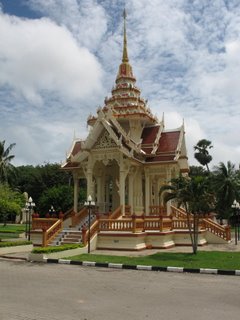
Our taxi driver had disappeared for the allocated two hours so we set off along the dark narrow streets looking for somewhere to eat and came across a small group of restaurants in the centre of the old town. Anna's was airconditioned and quite modern and served some of the best Thai food we had on the trip. Three courses plus beer and soft drinks and coffee for $A16 a head including tip!
All too soon we were back at the aiport for our short trip to Singapore made even shorter by an unexpected upgrade. Thank you Silk Air!
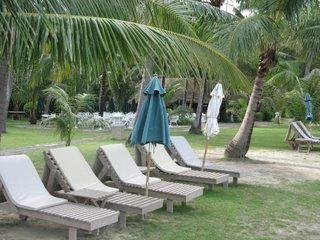
Back on Cape Panwa beach our empty chairs await our return.
Singapore is basically a huge shopping mall and restaurant. This island country is very crowded with a population of 15000 sq.mile accommodated in high rise condos, hotel towers and office blocks. The area is serviced by busy freeways and one of the best (and ever expanding) MRT's in the world. They have done a great job of greening the city with shady street trees and tropical gardens full with lush vegetation and colorful orchids. The city also boasts of numerous museums, art galleries, live theatres, a zoo, a bird park and botanical gardens. There is a fun park, Sentosa, on an outer island which attracts many tourists to its kitschy domain. Singapore also has one of the busiest ports in the world.
The first of my numerous visits here was in 1964. Things have sure changed since then. Under a somewhat ruthless and moralistic totalitarian government and the Chinese work ethic, the country has gone from third to first world in 40 years. Five percent of the population are millionaires. But there has been a price paid for this development. In my opinion that has been the de-asiaisation of the place. Culturally diverse centres like China Town, Little India, Arab Street and Bugis street are now mere shadows of their former selves and are kept in a sanatized form simply for the tourist industry.
Being a couple of degrees north of the equator Singapore is also a sauna. To make things worse, land clearing fires in Indonesia had caused a heavy pall of smoke to settle over the city. But all major shopping malls were well airconditioned and MRT connected so it was almost unnecessary to go outside.

Our main aim for the two days was shopping and eating. Singapore always has the latest in electronics, photographic and computer equipment as well as the largest selection of luxury goods with all major designer names represented. A huge amount of clothing and fabric is also on offer. Unfortunately the high standard of living means that prices are no longer as competitive as they used to be so much of our hard earned stayed in our pockets. But we still managed a great Chinese lunch washed down with Tiger beer at Clark Quay on the Singapore River as well as a wonderful steamed wonton dinner.
We even managed to fit in one last Thai meal before heading for the airport and home.














